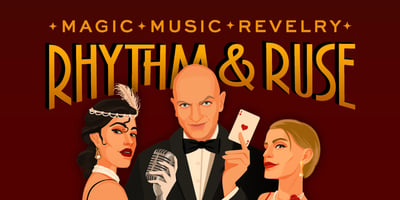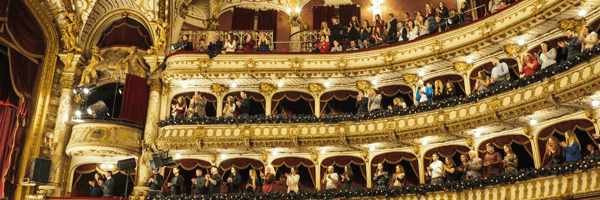We are thrilled to announce our newest and most unique partner, Rhythm & Ruse. Brought to you by...
The Future Of Immersive Theatre

Immersive experiences have gathered momentum in the last decade. Like a wave, the movement started with ripples - a couple of unique experiences, a few avant-garde productions - and over a fairly short period it has grown in size and strength and has now become an exciting and captivating part of the live entertainment industry. Yet, immersive theatre isn’t really new.
Shakespearean audiences were hardly passive. Ale-fuelled and rowdy, they hollered through performances and contributed in many ways to the dramatisations. In fact, the Globe Theatre was built in the almost-round to mirror the style of street performances where the crowd would encircle (or at least semi-circle) the production as it unfolded. The aim was not to distance the audience but to make them feel a part of the action. Even before this, the Romans had a similar approach to theatre, performing pantomimes that included audience participation. In the art world, many Renaissance artists painted on exceptionally large canvas so viewers could immerse themselves in the work.
Multiple artists, in the performing arts and the art world, have sought to break down the barriers between audience and artist expression, feeling the experience can be amplified when guests are active participants rather than passive observers.
Of course, not all audiences are comfortable with this. The term ‘audience-participation’ fills many with dread and they’ll always be those who relish the respectful quiet and darkness of watching a performance unfold at a comfortable distance.
However, this is one of the reasons why immersive theatre has seen a rise in popularity over the past decade - because they are managing to bridge the gap. Offering a unique way of breaking down the audience-performance barrier that doesn’t leave spectators feeling exposed or vulnerable.
Before we look at where the future of immersive arts might take us then, let’s look at the rise of modern immersive theatre and what various key players have done to reshape this art form for a modern audience.
The Rise of Modern Immersive Theatre
Two of the most influential players in immersive theatre, in the UK, have been Punchdrunk and Secret Cinema.
Founded in 2000 by Felix Barrett, Punchdrunk has been at the forefront of immersive theatre, with ground-breaking unique productions including The Burnt City and Sleep No More. Blending various art forms, including dance and music, to tell powerful and emotionally charged stories, the productions take place in large, intricately designed spaces that allow the audience to move through and around the environment. This untraditional delivery demands texts to be deconstructed so that stories unfold in a less linear manner. Yet, Punchdrunk audiences have found their appreciation of the performance and comprehension of the text to be enhanced by the sensory and physical aspects of the immersive experience.
More recently, Punchdrunk have been crafting quite a different theatrical experience. Transporting audiences back to the golden era of Jazz, Rhythm & Ruse is a production that will encompass cabaret, close-up magic, live music and stage shows within a 1920s secret society experience. VisitOne are delighted to have been selected as a partner, alongside Spektrix & Square, to ensure a streamlined experience for Rhythm & Ruse ticket-holders in this exciting new immersive theatre experience.
Another pivotal player in the immersive theatre scene has been Secret Cinema. Setting a high bar for immersive experiences, Secret Cinema world-build on a massive scale. Transforming large spaces so that audiences may fully immerse themselves in the event, the company has bypassed more classic forms of theatre and has instead focused on reimagining, or more aptly - recreating, popular film and television shows. Founded in 2007, Secret Cinema productions have included Back to the Future, Star Wars: Empire Strikes Back, Dirty Dancing and Stranger Things. Elaborate sets expand into every corner of the venue, incorporating food, drink, music and multiple other features and interactive experiences that uphold the theme. Giving visitors a recreation of a world they are already a cult follower of, or at least familiar with, means they may dress up and plunge themselves into the action with gusto which has a transmittable effect, elevating the authenticity of the event for all attendees. Leveraging the established fan base of popular films and TV shows, Secret Cinema have not relied on traditional theatre-goers to buy into their offering. They’ve won over followers of mainstream pop culture and, in doing so, have arguably brought a new audience into the performing arts arena, reaching those who have been unengaged with traditional theatre.
Across the pond, Third Rail production Then She Fell was embraced by the theatre lovers of New York. Self-described as an Alice In Wonderland type of experience that entices audiences down a rabbit hole of multi-sensory discovery, the story unravels in several different rooms and audience sizes are kept very small to support the somewhat solitary mystical adventure.
These diverse and innovative productions have helped solidify the appeal and rise of immersive theatre, making it a global phenomenon. Alongside the art world’s creative contributions, including Van Gogh and Salvador Dali immersive art experiences, the creative and performing arts world has harnessed the power of digital technology, visual effects and sound to create a whole new multi-layer art form. Establishing new fans of theatre and redefining how audiences engage with performance art. But nothing comes without a cost.
Challenges For Immersive Theatre Creators
When it comes to the challenges of immersive theatre, this emerging art falls victim to the usual suspects - cost, space and logistics.
Creating such vast sets and incorporating cutting-edge digital technologies is expensive. Staging productions with multiple art forms often demands additional specialists and directors. More front-of-house staff (or supporting actors) are often needed to manage the more fluid flow of the audience through the theatre space(s). This makes it difficult for theatre companies to create high-quality immersive experiences on a budget.
Space itself is a major obstacle as either very large environments or multi-room settings are required. Unlike traditional theatre, where the audience is confined to their seats, immersive theatre requires expansive environments that audiences can explore. Although the UK has undergone a sharp spike in unoccupied commercial buildings with the rise of remote working, finding a venue with a layout that works for these productions can be difficult.
Logistically, ensuring that every audience member has a fulfilling immersive theatre experience is a major endeavour, especially when they have the freedom to move around and interact with the performance. Creators must carefully choreograph the flow of the audience to support the narrative and ensure safety.
A unique challenge for immersive theatre is how to build an audience they can continue to develop. Yes, many traditional theatre-goers have been persuaded by modern immersive productions and companies like Secret Cinema have managed to attract new audiences into performance-based entertainment. However, some critiques are still tentative to confirm immersive experiences are not just a fly-by trend. Engaging audiences, not just once but enticing them to come back for future productions is essential. Furthermore, in the interest of futureproofing, immersive theatre creators need to find ways to embrace new-found audiences whilst bringing traditional theatre fans along on the journey.
The Future of Immersive Theatre
The future of immersive theatre is likely to be shaped by advancements in technology and supported by further incorporation of sensory elements. Virtual and augmented reality can offer exciting possibilities for creating even more immersive and interactive experiences.
As space continues to present a challenge for theatre companies staging immersive events, we may well see productions taking place outside of traditional theatre cities which could also contribute to helping new audiences discover this form of theatre.
Whilst Secret Cinema manages to find venues globally to stage productions, immersive art experience Frameless has taken up a permanent residence. It’s possible that immersive theatre may follow suit, seeking long-term venues that can handle the versatility of staging immersive theatrical experiences.
Immersive theatre can also incorporate additional experiences and elements that both enhance immersion but also create an opportunity for additional revenue streams. For example, offering food and drinks for guests that is theme-appropriate. Of course, this may present logistical difficulties, especially in terms of keeping your audience moving through the production. However, with pre-ordering, venues can support the production by ensuring refreshments are organised and delivered at the opportune moment. VisitOne’s platform offers a pre-ordering feature that venues and production managers may tailor to work with each event. Furthermore, our easily accessible ticket scanning system is reducing queuing and streamlining the visitor experience.
In a world where AI presents as many threats for creative communities as potential opportunities, movements like immersion in theatre are keeping human innovation and creativity alive and thriving. The success of both Punchdrunk and Secret Cinema, who have each selected wildly different source material, proves that there are multiple audiences able to find a home in the thrilling world of immersive performance art.




